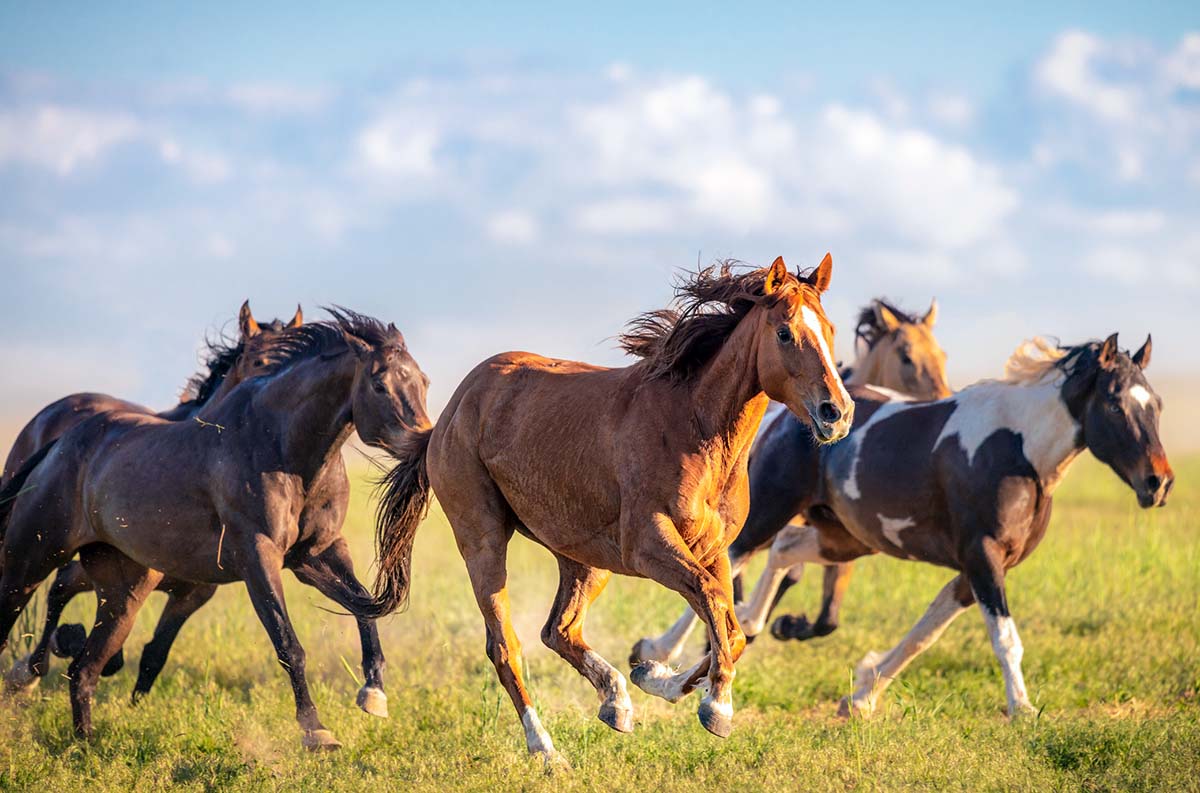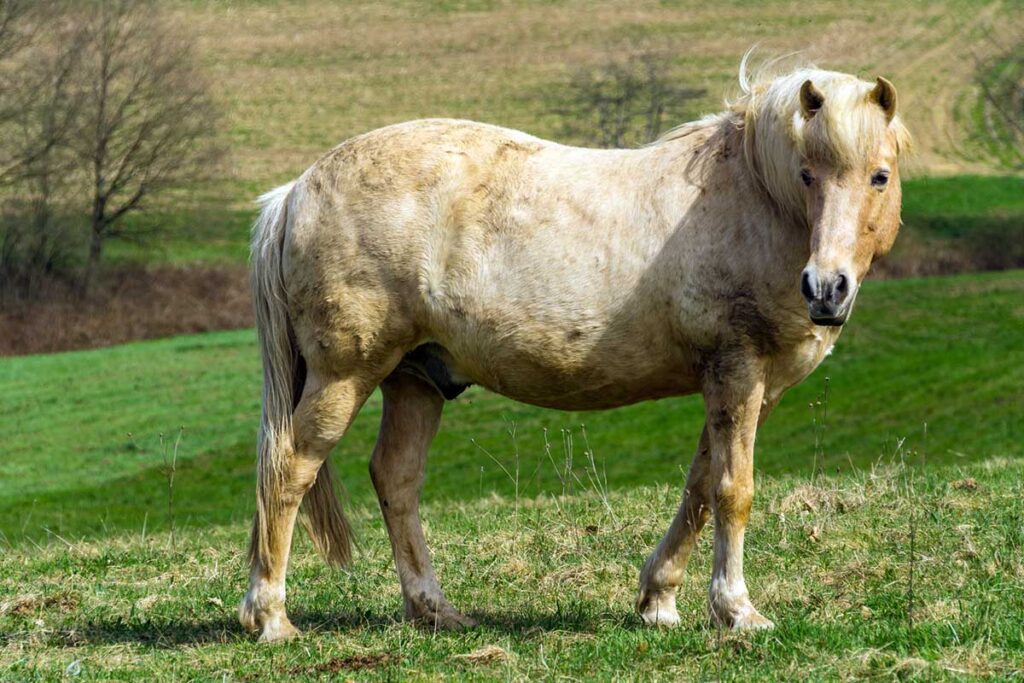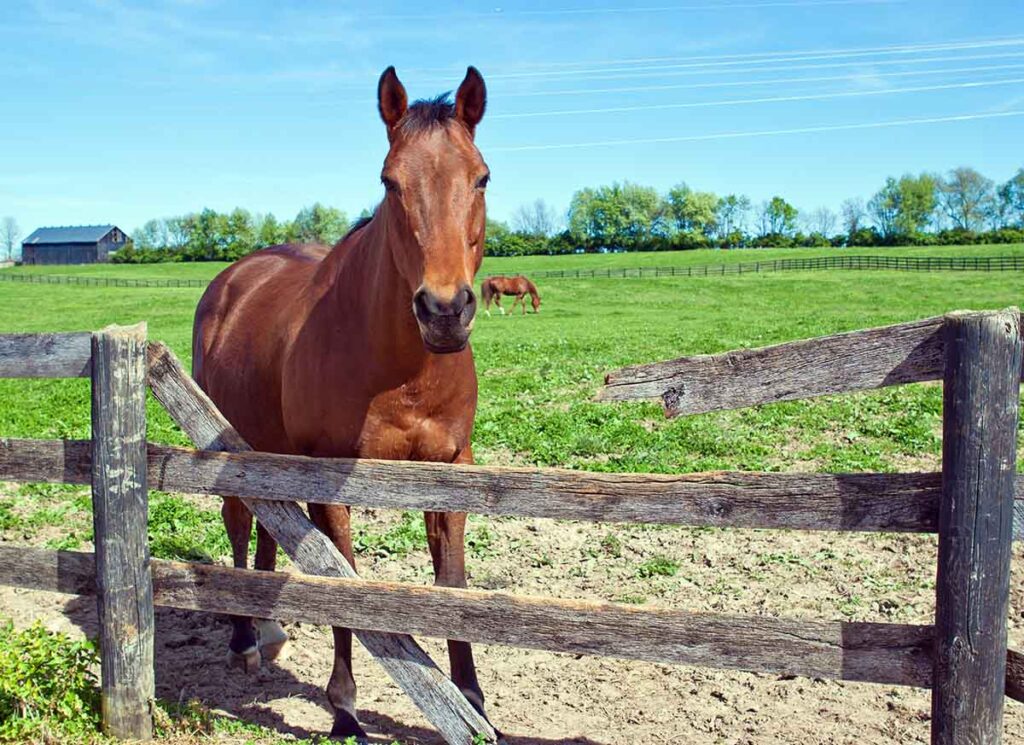Some horse breeds are easy to recognize—take the Appaloosa with its distinctive spots, for instance. Others, like the various European Warmbloods, share so many similarities they’re nearly indistinguishable from one other. Then there are breeds such as the Akhal-Teke that are rare and unparalleled.
Each horse breed has its unique characteristics and abilities. In this comprehensive guide, we’ll describe 33 of the hundreds that have evolved from selective breeding over the centuries. You might just discover one that would be a perfect fit for your riding needs.
Stock Horse Breeds

Stock horses were bred to work cattle and perform common ranch tasks. These horses are typically muscular and powerful, with a strong and sturdy build. They often excel in Western riding disciplines such as barrel racing, roping, and reining. Common types of stock breeds include:
American Quarter Horse
The American Quarter Horse is renowned for its incredible versatility, explosive power, and mild temperament. They typically have a solid, well-balanced build and a calm disposition. These horses are particularly famous for their ability to sprint short distances at remarkable speeds, which is how they earned their name—they can outrun other breeds in races of a quarter mile or less. Quarter Horses possess a natural adaptability that allows them to excel in various disciplines, including rodeo events, trail riding, and even jumping.
Appaloosa
The Appaloosa is a horse breed that stands out for its distinctive spotted coat. These horses are known for their hardiness and versatility, making them suitable for a wide range of activities, from trail riding and ranch work to English sports such as eventing and show jumping. Appaloosas are generally medium-sized with well-muscled bodies. Their unique coat pattern can vary greatly from horse to horse, giving each Appaloosa a one-of-a-kind look.
Paint Horse
The American Paint Horse is a versatile breed that has long captivated horse lovers with its colorful, unique coat patterns. Physically, they tend to have a strong, muscular build, a broad chest, and powerful hindquarters, making them excellent ranch and sport horses. They’re known for their brave and willing disposition.
Light Horse Breeds

Light horse breed characteristics include agility, elegance, and athleticism. These horses often excel in disciplines such as dressage, jumping, and racing. Popular types of light breeds include:
Thoroughbred
Thoroughbreds are known for their speed, work ethic, and spirit. While they’re most commonly associated with horse racing, their remarkable athleticism and endurance allow them to excel in many horse sports. Most Thoroughbreds have a lean body and long, slender legs. They often possess keen intelligence, willingness, and sensitivity.
Arabian
Arabians are one of the oldest horse breeds in the world, known for their beauty, endurance, and spirited nature. They have a refined and distinctive head shape and a strong, compact body with a high tail carriage. Renowned for their stamina, they can cover long distances in challenging conditions. While this trait makes them prized trail mounts, they also excel as show and companion horses.
Morgan
The Morgan Horse is an American breed known for its versatility, strength, and friendly disposition. This breed has a compact and muscular build, expressive eyes, and a distinctive arched neck. The Morgan’s stamina and agility allow them to be successful in a variety of English and Western disciplines, including dressage, jumping, Western pleasure, and driving. They often have animated gaits, especially at the trot.
Standardbred
The Standardbred is an American breed best known for its prowess in harness racing. They excel in two gaits—pacing and trotting—and are exceptionally good at maintaining a fast pace over long distances. Their stamina and steady temperament also make them suitable for recreational riding, trail, and other equestrian activities. Standardbreds typically have a muscular build, solid bone structure, and long stride.
Akhal-Teke
The Akhal-Teke is a horse breed from Turkmenistan, renowned for its speed, endurance, and metallic sheen. Their coats have a unique luster that gives them an elegant appearance. Most Akhal-Tekes have a slim, athletic build with long legs. They’re intelligent, sensitive, and hardy enough to withstand conditions in which other breeds would struggle. This breed excels in trail and endurance-type sports as well as disciplines such as jumping and dressage.
Miniature Horse
Not to be confused with ponies, Miniature Horses are tiny versions of full-sized light-breed horses. They’re well-balanced and proportional, with beautiful features and curious, intelligent personalities. According to breed standards, they must not exceed 34 inches in height. Miniature Horses are suitable for driving, showing in hand, therapy work, and as pets.
Gaited Horses

Gaited horses are bred to move each limb independently when traveling at a fast walk, trot, or higher gait. The result is a smooth riding experience and the ability to conserve energy over long distances. Riders often prefer these horses for trail and endurance riding.
Icelandic Horse
Icelandic horses are known for their small stature, hardy nature, and specialized gaits. While most breeds have three or four natural gaits (walk, trot, and canter/gallop), Icelandic horses have five. In addition to the standard gaits, they perform the tölt, an incredibly smooth four-beat gait, and the flying pace, a speedy two-beat lateral gait. Despite their size, Icelandic horses are incredibly strong, often ridden by adults as well as children for both leisure and competition.
Tennessee Walking Horse
The Tennessee Walking Horse has three distinct gaits: the flat-foot walk, running walk, and canter. The most notable of these is the running walk, a smooth, gliding gait that is faster than most horses’ walks, offering a comfortable ride over long distances. This breed also performs a “rocking chair” canter, which is a relaxed three-beat gait. Tennessee Walking Horses possess a calm temperament, making them excellent choices for novice riders or those seeking a leisurely trail horse.
Missouri Fox Trotter
The Missouri Fox Trotter’s signature gait is the “fox trot,” a four-beat gait with no suspension, providing a smooth ride. Two feet are always in contact with the ground, making this gait particularly useful over rough terrain. These horses also perform a flat-footed walk and a canter. Beyond their gaits, Missouri Fox Trotters are known for their endurance, soundness, and calm demeanor. They are versatile horses, suitable for a variety of activities, including trail riding and ranch work.
Rocky Mountain Horse
The Rocky Mountain Horse’s signature gait is the “single-foot” or “amble,” a smooth and comfortable four-beat lateral gait that makes for an enjoyable ride over long distances. Rocky Mountain Horses also walk, canter, and gallop. They have a good demeanor, strength, and endurance and are often used for trail riding, showing, and farm work. With their distinctive chocolate-colored coat and flaxen mane and tail, Rocky Mountain Horses are also beautiful and unique.
Paso Fino
This small horse is renowned for its comfortable, rhythmic, and balanced Paso Fino gait, a quick, short stride that provides an exceptionally smooth ride. This four-beat lateral gait, performed at three speeds, is natural and often exhibited from birth. Paso Fino horses are intelligent, sensitive, and willing to please. They are versatile, excelling in disciplines ranging from trail and endurance riding to Western classes, driving, and drill team.
Saddlebred
The American Saddlebred has a long, arched neck, expressive eyes, and a muscular, well-proportioned body. They have two unique gaits in addition to the standard walk, trot, and canter: the four-beat slow gait and the fast-paced, flashy rack. Both gaits provide a smooth and comfortable ride, making Saddlebreds ideal for pleasure and saddle seat riding.
Draft Horses

Draft horses are large and muscular workhorses bred to perform tasks such as hauling heavy loads and farming. Today, they also make good driving and riding mounts and often appear in parades and ceremonies.
Clydesdale
The Clydesdale boasts great size (usually 16-18 hands), strength, and a distinctive appearance—typically bay with extensive white markings and leg feathering. They have powerful, high-stepping gaits but a gentle demeanor. You might find Clydesdales pulling heavy loads, performing farmwork, participating in parades, and being ridden.
Belgian Draft
The Belgian Draft horse has immense strength, a robust physique, and a gentle, willing disposition. Often standing between 16 and 17 hands, they have a broad, muscular body, a thick neck, and powerful legs, making them highly efficient for heavy work. Their calm temperament makes them easy to handle despite their size. Belgian Drafts might plow fields, pull carriages, and participate in draft horse competitions.
Shire
The Shire is one of the largest and strongest horse breeds in the world. Standing, on average, 17 hands and taller, Shires are known for their massive size, muscular build, distinctive lower leg feathering, and good-natured temperament. Traditionally used to pull heavy loads because of their incredible strength, today these horses are suitable for driving, agriculture, and show.
Percheron
The Percheron combines power and elegance. Bred for size, strength, and pulling heavy loads, Percherons move with surprising agility and grace. Their gaits are smooth and energetic, offering a comfortable ride and efficient pace. They are generally calm and easygoing, suitable for farm work, carriage driving, and riding.
Norwegian Fjord
The Norwegian Fjord, one of the world’s oldest breeds, is versatile, hardy, and adaptable. These horses are small but incredibly sturdy, standing between 13.2 and 15 hands. They have a compact, muscular body and a distinctive dun color with a bold dorsal stripe. One of the Norwegian Fjord’s most notable features is its mane, which owners usually crop short to reveal the characteristic black stripe that runs through its center. Despite their size, these horses possess great endurance and can easily carry adults over long distances, making them popular riding horses.
Gypsy Vanner
This medium-sized draft-type breed has a powerful build and a striking appearance. They commonly have a pinto coat pattern, abundant feathering on the lower legs, and a long, flowing mane and tail. Despite their robust physique, Gypsy Vanners move with grace and agility. They are calm, friendly, and intelligent, making them excellent family horses suitable for equestrian activities ranging from driving to dressage.
Haflinger
Haflingers are small but robust horses bred for draft work and riding. They typically stand between 13.2 and 15 hands, making them ideal for both adult and younger riders. Haflingers have a distinctive golden chestnut coloring and a sturdy build. They excel in various disciplines, including dressage, show jumping, driving, and endurance riding, showcasing their agility, strength, and stamina. Their smooth gaits, natural balance, and impressive pulling power make them particularly suited for driving.
Ponies

Ponies are shorter than horses (below 14.2 hands), but they still pack a punch in terms of personality and ability. Ponies have a reputation for being strong-willed and independent but make excellent riding and driving companions. Because of their small stature, they’re popular choices for kids’ mounts.
Welsh Pony
Welsh Ponies are strong, intelligent, and versatile. They come in varying heights and types, ranging from the Welsh Mountain Pony to the Welsh Cob. Despite their small stature, they are well-balanced, strong, and highly adaptable. Known for their spirited yet gentle nature, Welsh Ponies excel in a variety of disciplines, from dressage and jumping to driving and pleasure riding. Their friendly temperament and adorable appearance make them particularly popular with children.
Shetland Pony
Shetland Ponies are celebrated for their strength, resilience, and disposition. They stand no taller than 10.2 hands but are robust enough to carry heavy loads up to twice their body weight. Their thick double coat and short ears give them a distinctive look and hardiness in harsh weather conditions. Shetland Ponies are generally intelligent, good-natured, and easily trainable, making them good riding and driving ponies for children and beginners.
Connemara Pony
Connemaras are strong and athletic ponies that typically stand between 12.2 and 14.2 hands high. They have a sturdy build, with a deep chest, well-muscled neck, and strong hindquarters. Because of these physical traits, they perform well in eventing, jumping, and dressage. Connemaras are also known for their hardiness, adaptability, intelligence, and willing temperament, making them suitable for both adults and children.
Spanish Breeds

Several popular breeds known for their beauty, elegance, and stamina originated in Spain. You’ll commonly hear them referred to as Spanish or Iberian horse breeds. They typically excel in dressage, bullfighting, and driving. Here are a few of the most common:
Andalusian
The Andalusian, also known as the Pure Spanish Horse or PRE (Pura Raza Española), is famous for its beauty, agility, and intelligence. These horses typically stand between 15.2 and 16.2 hands tall. They have a distinctively strong and muscular build, with broad, long backs and powerful hindquarters. Andalusians excel in a wide range of disciplines, from dressage and jumping to driving and working equitation. Their agile and energetic movement, coupled with their natural balance, make them particularly suited for classical dressage.
Lusitano
The Lusitano has a compact yet muscular build, with a broad chest, strong legs, and powerful hindquarters. Like Andalusians, Lusitanos are known for their natural ability to perform advanced dressage movements, making them suitable for classical dressage. They are also versatile enough to excel in equestrian sports like show-jumping and driving and can do farm work and bullfighting.
Warmbloods

Warmblood horses originated when European breeders began crossing draft horses with lighter breeds. The result is a big-bodied yet athletic horse. Riders often select them for disciplines that require both power and agility, such as hunters, jumpers, dressage, and eventing.
Hanoverian
Hanoverians are one of the oldest Warmblood breeds. They typically stand between 15.3 and 17.2 hands high and possess strength, athleticism, and versatility. Hanoverians excel in dressage, show-jumping, eventing, and driving due to their agility, stamina, and exceptional movement. They have long, rhythmic strides and natural balance, as well as willingness and a good temperament. As a result, they’re suitable for both professional competitors and amateur riders.
Dutch Warmblood
Typically standing between 15.2 and 17 hands, Dutch Warmbloods demonstrate a balance of strength and elegance. Like most Warmbloods, they excel in dressage, show-jumping, and eventing and possess a calm and willing temperament. Their smooth, elastic gaits and natural balance make them particularly suitable for dressage. The Dutch Warmblood’s combination of athleticism, versatility, and temperament makes it a premier sport horse breed.
Friesian
Friesians are striking and powerful horses known for their elegance and versatility. They have a distinctive black coat, long flowing mane and tail, and feathered legs. Friesians excel in various equestrian disciplines, including dressage and driving. Their smooth, rhythmic gaits, flashy trot, and natural balance make them particularly suited for dressage. Professional competitors and recreational riders alike appreciate the breed for its beautiful appearance, willingness to work, and generally calm temperament.
Wild Horses

Wild horses, as the name suggests, live undomesticated and free. Very few truly wild horses still exist worldwide, though several free-roaming breeds receive protection by government or wildlife conservation organizations. These include:
Mustang
More than 80,000 Mustangs roam freely in the Western United States. They are typically mid-sized, standing between 13 and 15 hands, and exhibit a rugged build with strong legs, a deep chest, and hardy hooves. They display diverse coat colors ranging from traditional black and bay to pinto and palomino. Mustangs have evolved to be surefooted, strong, and resilient. When domesticated and trained, they excel in disciplines such as trail riding, endurance, and dressage. Their stamina, agility, and natural balance make them well-suited for long-distance riding and working on varied terrain.
Brumby
Brumbies are feral horses that live in parts of Australia. They typically stand between 13 and 15 hands and have evolved to survive the country’s harsh, varied climates. Their diverse gene pool includes Thoroughbred, draft horse, Arabian, and pony bloodlines. Domesticated Brumbies often make good trail and endurance horses adept at working in challenging terrain, thanks to their stamina, balance, and agility.
Przewalski’s Horse
The endangered Przewalski’s horse is the only truly wild breed on earth, residing in Mongolia. These small yet hardy horses usually stand between 12 and 14 hands, with a robust and stocky build. Their dun-colored coats change with the seasons, becoming thick and woolly in the winter for warmth and shedding to a sleeker coat in the summer. These horses are incredibly tough and resilient, with impressive stamina and agility that make them well-suited for survival in challenging terrains.
Take-Home Message
Understanding the different horse breeds can help you find the right equine companion. Whether you’re looking for a stock horse for ranch work, a light horse for jumping, or a gaited horse for the trail, you’ll find a breed out there to suit your riding style and preferences. Remember that horses vary individually even within a breed, so consider personality, behavior, and ability in addition to appearance.
Are you enjoying this content? Sign up for My New Horse’s FREE newsletter to get the latest horse owner info and fun facts delivered straight to your inbox!








